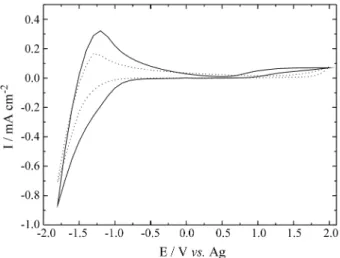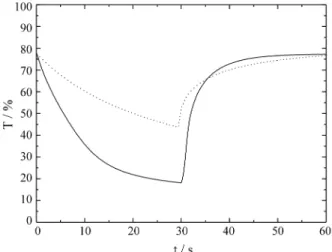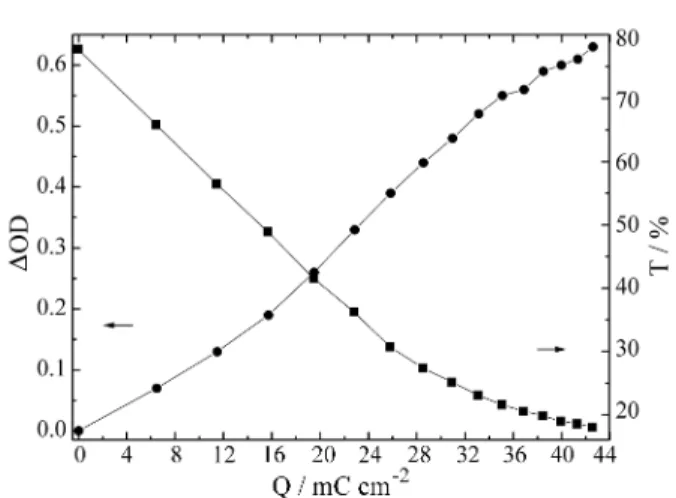Electrochromic Properties of Sol-gel Coating
of Nb
2O
5and Nb
2O
5:Li
+L. Meloa, C.O. Avellanedab, R. Caramc, E. Sichieric, A. Pawlickaa*
aDFQ, IQSC - USP, C.P. 780, 13560-970 São Carlos - SP, Brazil
bLIEC, DQ - UFSCar, C.P. 676, 13565-905 São Carlos - SP, Brazil cDAU, EESC - USP, 13560-970 São Carlos - SP, Brazil
Received: November 13, 2000; Revised: December 29, 2001
Thin solid films of Nb2O5 and Nb2O5:Li+ were prepared by the sol-gel process using the
sonocatalytic method. The films reported here were prepared from a NbCl5 as precursor and butanol
as solvent. Through the addition of lithium salt LiCF3SO3 to the precursor solution, films with
different electrochemical performance were obtained. The electrochemical and optical responses of the films were determined from the cyclic voltammetry and chronoamperometry measurements using a 0.1 M LiClO4/PC as electrolyte. The electrochromic properties of the films were investigated
using in situ spectroelectrochemical method. They exhibit a gray coloration under Li+ insertion with a reversible variation of the transmittance in the visible and near infrared range between 20% and 80%.
Keywords:electrochromism, Nb2O5, sol-gel
1. Introduction
In recent years, there has been considerable interest in the good use of solar energy. The development of new technologies in this area has increased over the past years. Such energy is very much applied and one of its utilizations is in electrochromic devices (windows, displays, sun-glasses, mirrors). A large class of optically active materials has drawn scientific interest, especially the ones with trans-mission, absorption and reflectance control. These materi-als are known as chromogenous as their color change when an external field is applied. Some studies have reported the electrochromic properties of many materials such as TiO2,
WO3, V2O5, Nb2O5 etc. The electrochromic properties of
these materials are related with the insertion of small ions like Li+ or H+ in their structures1-3.
Pure and doped niobium(V) oxides (Nb2O5) are
prom-ising cathodic electrochromic materials. Their electro-op-tical performance depends strongly upon their structural morphology. They can be obtained as films by sol-gel process. This well-know process is a good method to achieve such morphology and combined with dip-coating technique is possible to deposit a large area coating at a low cost as well as to control the microstructure of the films.
Since Richman and Bard’s4 observation on coloring effect in Nb2O5 under H+ or Li+ insertion, several studies
of electrochromic behavior of these materials have been reported. Gomes et al.5 found an opaque blue coloration in Nb2O5 grew thermally at ~500 °C on a niobium metallic
disk. Alves et al.6 has confirmed the possibility of inserting Li+ ions into an Nb2O5 ceramic prepared from a
commer-cial powder sintered at 800 °C. The first attempt to produce sol-gel films of Nb2O5 for electrochromic purpose has been
reported by Lee and Crayston7 using a sol made from a mixture of NbCl5 dissolved in ethanol. Using a sol prepared
with niobium pentachloride via Na process, homogenous films without cracks have been obtained, showing good electrochromic properties8-10. Faria et al.11 prepared Nb-oxide films from an NH4H2[NbO4C2O4)3]3H2O precursor
dissolved in a solution of citric acid and ethylene glicol. Also Nb2O5 films were prepared by the sonocatalytic
method12. In order to improve the bleaching process, Macek et al.15 have prepared films of Nb2O5 doped with
lithium salt (LiCF3SO3) according to Barros Filho et al.16
procedure. These sols were obtained by the solubilization of NbCl5 in propanol for 24 h, and the addition of glacial
acetic acid and LiCF3SO3. These sols resulted in Li/Nb
molar ratio of 0.1 and 0.2.
Materials Research, Vol. 5, No. 1, 43-46, 2002. © 2002
*e-mail: agnieszka@iqsc.sc.usp.br
This paper deals with a study of electrochemical and optical properties of 3 layer coatings of Nb2O5 doped with
LiCF3SO3 films utilizing the sonocatalytic sol-gel route
and dip coating deposition technique. The sonocatalytic sol-gel route is fast and easy to prepare niobium sol. The films demonstrated excellent bleaching kinetics and gray coloration during the insertion of Li+. These very good optical quality films can be used probably in architecture applications where the minimum coloration is necessary.
2. Experimental
2.1. Preparation of the sol
The starting solution to produce Nb2O5 films was
pre-pared by dissolving NbCl5 powder (1.3 g, 0.005 mol) in
butanol (15 mL, 0.16 mol), acetic acid (3 mL, 0.05 mol) and LiCF3SO3 salt, (10 %mol). The solution mixture was
submitted for ~5 min to the action of a 95 W, 20 kHz ultrasonic irradiation from a sonicator resulting in a trans-parent and viscous solution.
2.2. Preparation of the films
The coatings were deposited by dip-coating method on ITO coated glass substrates (Asahi Glass 14 Ω/ ) pre-viously cleaned and rinsed with bidestilled water, ethanol and then dried at room temperature. The ITO glasses were immersed into the solution in ambient atmosphere (RH 60%) and withdrew at rate of 10 cm/min, dried at room temperature for 5 min and then sintered at 450 °C during 5 min. The process was repeated to obtain 3 layer films. The final heat treatment was performed at 560 °C in air atmosphere for 15 min. The resulting coatings were trans-parent and homogeneous without any visual cracking.
2.3. Measurement technique
Cyclic voltammetry measurements were performed with AUTOLAB 30 equipment and General Purpose Elec-trochemical System (GPES) for Windows - version 4.7 and the chronoamperometry experiments were performed with an EG&G PAR 273 computer-controlled potentiostat/gal-vanostat controlled by 270 Electrochemical Analysis soft-ware. A conventional three-electrode cell was used, a platinum foil of 1 cm2 was the counter-electrode and a silver wire was the quasi-reference electrode. The electro-lyte was 0.1 M solution of LiClO4 dissolved in propylene
carbonate (PC) and the cell was previously purged with dry N2 gas. The UV-Vis spectra of the films were recorded in
situ with a 5G model Varian spectrophotometer and the coated substrate was placed in a special electrochemical cell with two flat quartz windows.
3. Results and Discussion
The cyclic voltammograms for Nb2O5 doped and
un-doped films are depicted in Fig. 1, by sweeping the poten-tial the range of -1.8V to +2.0V. It can be observed that, close to -1.0 V, there is an increase in the cathodic current associated with Nb2O5 reduction with simultaneous Li+
cation insertions. During this process it is observed a change in the optical properties of the films, from transpar-ent to gray color. After changing the pottranspar-ential sweep direc-tion, the lithium deintercalation close to -1.5 V started, followed by a peak at E =-1.2 V. Both films showed the same voltammetric shape, but the Li doped film reached higher current values when compared with non-doped films. The same tendency was observed for the charge densities as a function of time measurements during a potential step at intervals of 30 s between -1.8 V (colored state) and +2.0 V (bleaching state) (Fig. 2). The film doped with lithium showed a better electrochromic performance
(42 mC/cm2) than the undoped one, where the charge
density was 29 mC/cm2.
The transmittance variation as a function of time at λ = 550 nm during a potential step at intervals of 30 s between -1.8 V (colored state) and +2.0 V (bleaching state) is showed in Fig. 3. Doped films exhibited intensive color-ing/bleaching changes (Tb - Tc = 59%) where Tb and Tc are
transmittances (in %) of bleached and colored films, re-spectively while undoped film showed Tb - Tc = 33%. In
addition doped films exhibited higher reversibility in the coloring/bleaching process when compared with undoped films. They showed an excellent performance where their original transmitting value was restored (approximately 77%). The two curves show that the charge insertions were 30 s, but the lithiated film showed only 20 s for extraction.
44 Melo et al. Materials Research
This fact can explain the influence of Li+ present in the structure of the film. This was assumed to be due to the increased ionic conductivity of films originated from the presence of lithium14. It probably facilitates the exit of the charges inserted when an anodic potential is applied.
The color changes for doped and undoped Nb2O5 films
were performed by in situ visible measurements from 350 nm to 800 nm (Fig. 4). The results show that the films exhibit a different spectral transmission, where the lithiathed film exhibits much higher transmission differ-ence values between colored and bleached states. For the doped films it was observed a transmission of 18% for colored and 72% for the bleaching state and for undoped film, 40% for colored and 75% for bleaching state.
The importance of using doped films with Li+ is the improvement of the bleaching kinetics, which helps their electrochromic properties15.
The analysis of the optical density variation and trans-mittance versus density charge for Nb2O5 films
un-lithiathed and un-lithiathed is shown in Figs. 5 and 6. It can be observed that, for all cases, the films were transparent with an initial transmission about of about 80%. As the charge was inserted, there was an initial linear increase in ∆OD, followed by saturation. The initial linear increase is to be expected from the Beer-Lambert law, and the slope of this gives the electrochromic efficiency (η) of 9.5 cm2/C and 19 cm2/C for undoped and doped films respectively.
4. Conclusions
A sonocatalytic method was used for the preparation of stable, cheap and easy to prepare niobium oxide sol. Sol-gel doped Nb2O5 films have shown better electrochromic
prop-erties evidenced by a larger transmittance difference be-tween colored and bleached states than undoped films. The difference between both states was about 59% for doped
Vol. 5, No. 1, 2002 Electrochromic properties of sol-gel coating of Nb2O5 and Nb2O5:Li+ 45
Figure 3. The variation of transmittance at λ = 550 nm as a function of time during a potentiostatic step between -1.8 V and +2 for 30 s, undoped (...) and doped 10%mol of lithium (-).
Figure 4. In situ UV-Vis spectra observed during electrochromic switch-ing in the bleached (+2.0 V) and colored states (-1.8 V) of niobium oxide films, undoped (...) and doped 10 %mol of lithium (-).
Figure 2. Charge density of the niobium oxide film undoped (...) and doped 10 %mol of lithium (-), interval step of -1.8 V and +2.0 V for 30 s.
films and 33% for undoped one. It probably occurs because Li+ in its structure improves the bleaching kinetics. Both films showed high charge density inserted, but the doped ones showed best coloration and reversibility behavior reaching the bleaching state faster than undoped films. The maximum charge density inserted into a tree-layer coating was 42 mC/cm2. The sonocatalytic route is easy and cheap and the preparation of the sols is quick, giving promising results.
Acknowledgment
The authors would like to acknowledge the financial support given by FAPESP.
References
1. Granqvist C.G. Handbook of Inorganic
Electro-chromic Materials, Elsevier, Amsterdam, 1995.
2. Monk, P.M.S.; Mortimer, R.J.; Rosseinsky, D.R.
Electrochromism Fundamental and Applications, VCH Weinhein, 1995
3. Aegerter, M.A. Sol-Gel Chromogenic Materials and Devices, Structure and Bonding, v. 85, p. 149-194, Springer, Berlin Heildelberg, 1996
4. Reichman, B.; Bard, A.J. J. Eletrochem. Soc., v. 127, n. 1, p. 241-242, 1980.
5. Gomes, M.A.B.; Bulhões, L.O.S.; Castro, S.C.; Damião, A.J. J. Eletrochem. Soc., v. 137, n. 10, p. 3067-3070, 1990.
6. Alves, M.C. Msc. Thesis, Federal University of São Carlos, São Carlos, Brazil, 1989.
7. Lee, G.R.; Crayston, J.A. J. Mater. Chem., v. 1, n. 3, p. 381-386, 1991.
8. Avellaneda C.O.; Aegerter M.A; Pawlicka A.
Química Nova, v. 21, n. 3, p. 365-367, 1998. 9. Avellaneda C.O.; Pawlicka A.: Aegerter M.A. J.
Ma-ter. Sci., v. 33, n. 8, p. 2181-2185, 1998.
10. Aegerter M.A.; Avellaneda C.O.; Pawlicka A.; Atik M. J. Sol-Gel Sci. Techn., v. 8, n. 1-3, p. 689-696, 1997.
11. Faria R.C.; Bulhões L.O.S. J. Electrochem. Soc, v. 141, n. 3, p L29-L30, 1994.
12. Pawlicka A.; Atik, M.; Aegerter, M.A. Thin Solid Films, v. 301, n. 1-2, p. 236-241, 1997.
13. Ohtani B.; Iwai, K.; Nishimoto, S.; Inui, T. J. Electro-chem. Soc., v. 141, n. 9, p. 2439-2442, 1994.
14. Ozer, N.; Chen, D.G.; Lampert, C.M. Thin Solid
Films, v. 277, n. 1-2, p. 162-168, 1996.
15. Macek, M.; Orel, B.; Krasovec, U.O. J. Electrochem. Soc., v. 144, n. 9, p. 3002-3010, 1997.
16. Barros Filho, D.A.; Abreu Filho, P.P.; Werner, U.; Aegerter, M.A. J. Sol-Gel Sci. Technol., v. 8, n. 1-3, p. 735-742, 1997.
FAPESP helped in meeting the publication costs of this article
46 Melo et al. Materials Research


